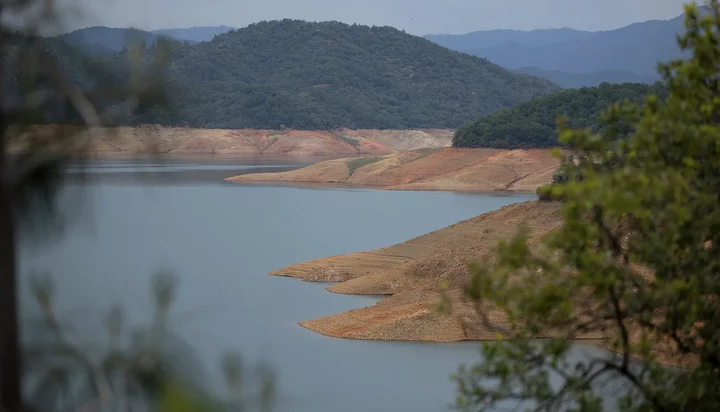Low water levels at Shasta Lake on April 25, 2022. The reservoir as of Feb. 21 , 2023 was at more than 86% of historic average levels. Photo by Miguel Gutierrez Jr., CalMatters
California’s water board decided Tuesday to temporarily allow more storage in Delta reservoirs, waiving state rules that require water to be released to protect salmon and other endangered fish.
The waiver means more water can be sent to the cities and growers that receive supplies from the San Joaquin-Sacramento Delta through the State Water Project and the federal Central Valley Project. The state aqueduct delivers water to 27 million people, mostly in Southern California, and 750,000 acres of farmland, while the Central Valley Project mostly serves farms.
The flow rules will remain suspended until March 31.
Environmentalists reacted today with frustration and concern that the move will jeopardize chinook salmon and other native fish in the Delta that are already struggling to survive.
“The flow standard they relaxed is probably the most important regulation we have,” said Gary Bobker, program director at The Bay Institute. He said the rule is aimed at simulating natural runoff in rivers, which is critical for native fish to reproduce and thrive.
The order from the State Water Resources Control Board, signed by Executive Director Eilleen Sobeck, comes eight days after Gov. Gavin Newsom suspended two state environmental laws and urged the board to act. Water suppliers and growers had criticized the state for “wasting” water during the January storms by letting it flow through rivers out to sea instead of capturing it in reservoirs.
On the day that Newsom issued his order, the state Department of Water Resources and the U.S. Bureau of Reclamation — which oversee reservoirs and water exports in the Delta — petitioned the board to lift the flow rules.
San Francisco Baykeeper Science Director Jon Rosenfield said this is the third year in a row, and the sixth time in 10 years, that the state has waived its rules that set basic flow standards in the Delta. The previous waivers were issued because of severe drought conditions, while the new waiver was triggered by the opposite: high-volume storm conditions.
“The governor is taking water from winter-run Chinook salmon, which just experienced their worst incubation season ever,” Rosenfield said. “The few that remain could be given a better chance of surviving to the ocean. Instead, they’re going to get worse conditions.”
Water that flows through the Delta and into San Francisco Bay helps young salmon complete their seaward migrations through the estuary, and it improves the estuary’s salinity conditions to the benefit of many species.
If the state’s Delta flow rules had remained in effect, water would have to flow through the Delta at a rate of 29,200 cubic feet per second. But as of Feb. 21, outflow was less than half that,14,300, Rosenfield said.
Sobeck acknowledged in her order that fish benefit from the flow rules and they “are specifically intended to provide for some population growth of native estuarine species.” But after weighing the cost of harming fish with the benefit of providing water for farms and cities, she made the choice “to maintain and expand water supplies given prolonged drought and uncertain climatic conditions.”
Sobeck wrote that the waiver is permissible only if it’s made in the public interest and “that the changes will not result in unreasonable effects to fish and wildlife.”
Winter-run and spring-run Chinook salmon, tiny Delta smelt and several other Delta fish species are listed as threatened or endangered by the state and federal Endangered Species Acts, which prohibit harm to protected species.
Karla Nemeth, director of the California Department of Water Resources, and Ernest Conant, regional director of the U.S. Bureau of Reclamation, said that lifting the flow requirements was unlikely to harm Delta fish.
“Our modeling shows that January’s wet hydrology, along with operational actions…, created conditions that will be protective of species throughout February and March,” they wrote in a letter to the water board.
To allow the water board to waive the flow rules, Newsom’s order suspended two state laws — Water Code Section 13247, which requires state agencies to comply with all water-quality rules, and Public Resources Code, Division 13, which ensures environmental quality, and its regulations.
Environmentalists lambasted Newsom last week, saying that the governor was “putting his thumbs on the scale in favor of extinction in the Delta” and “eviscerating environmental laws” with the stroke of his pen.
But water suppliers applauded the decision today, saying the water is needed to help provide enough water to cities and farms. Currently they are only receiving 30% of requested deliveries from the state aqueduct.
“This grants water users a little cushion,” said Tim Quinn, an affiliate with Stanford’s Water in the West program and a former executive director of the Association of California Water Agencies. “It leaves a little more water in storage than we would have had.”
Fed by the January storms, the state’s main reservoirs, Oroville and Shasta, which had been parched by drought, are at 116.5% and 86.6% of historic average levels.
Although the state received heavy criticism last month for not capturing more water, Bobker said California “did a pretty good job.” His organization estimated that almost half the rain that fell in the Sacramento and San Joaquin watersheds in December and January was captured in reservoirs.
The storms also heavily padded the Sierra Nevada snowpack, which is now at about 200% of average and will melt and drain into reservoirs later this spring.
“But they wanted more, so they suspended the rules,” Bobker said. “It’s not even a drought. If we can’t provide good conditions for fish in a year like this, then we are totally bankrupt as resource managers.”
###
CalMatters.org is a nonprofit, nonpartisan media venture explaining California policies and politics.

CLICK TO MANAGE